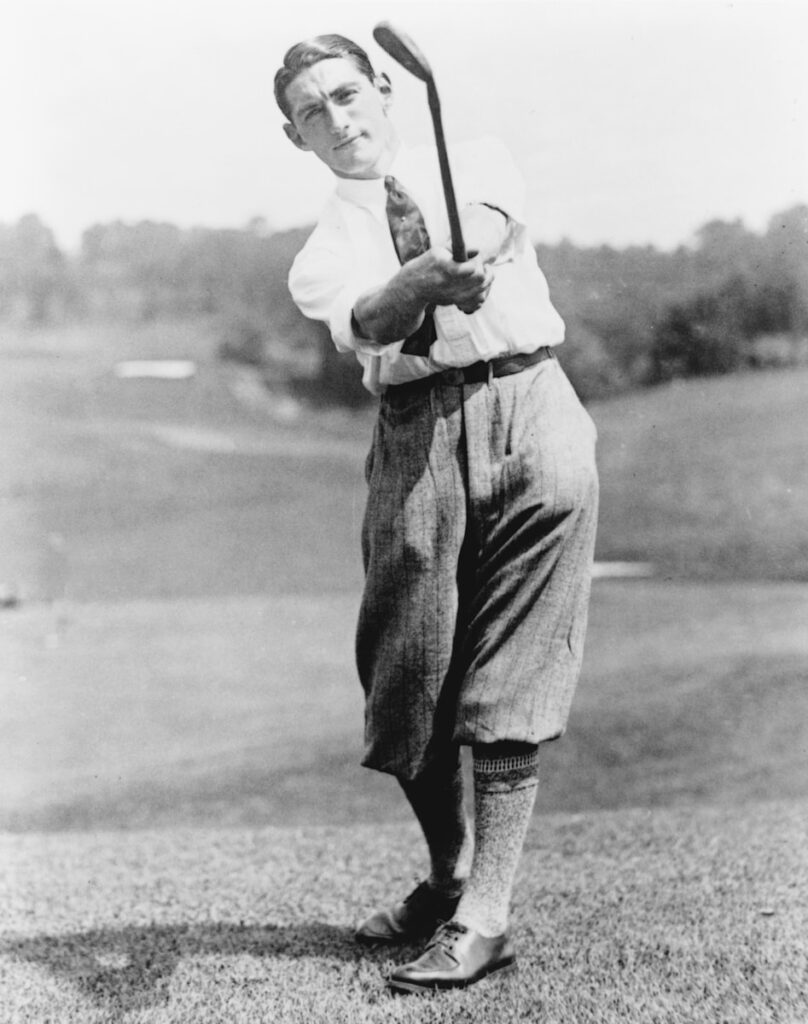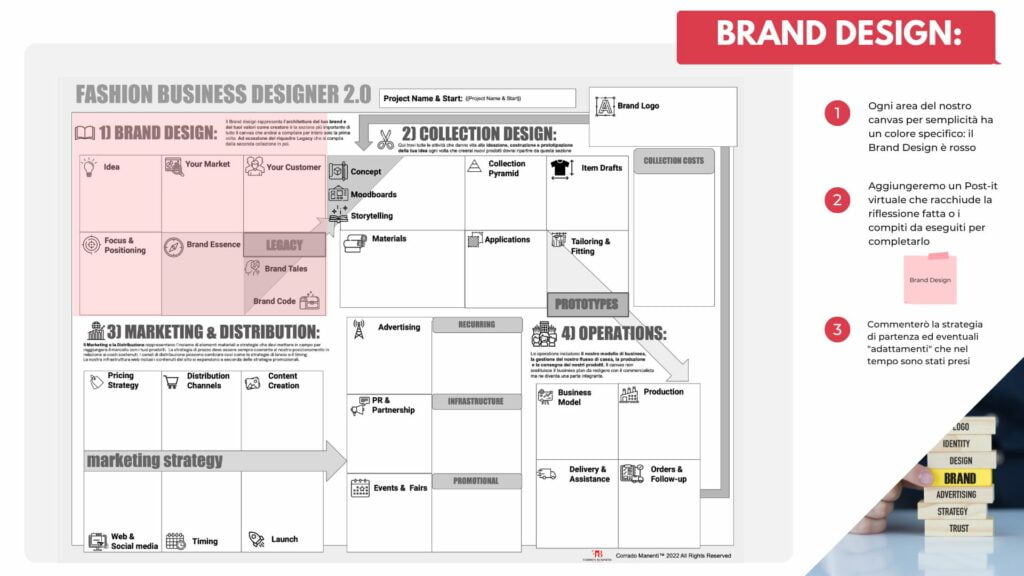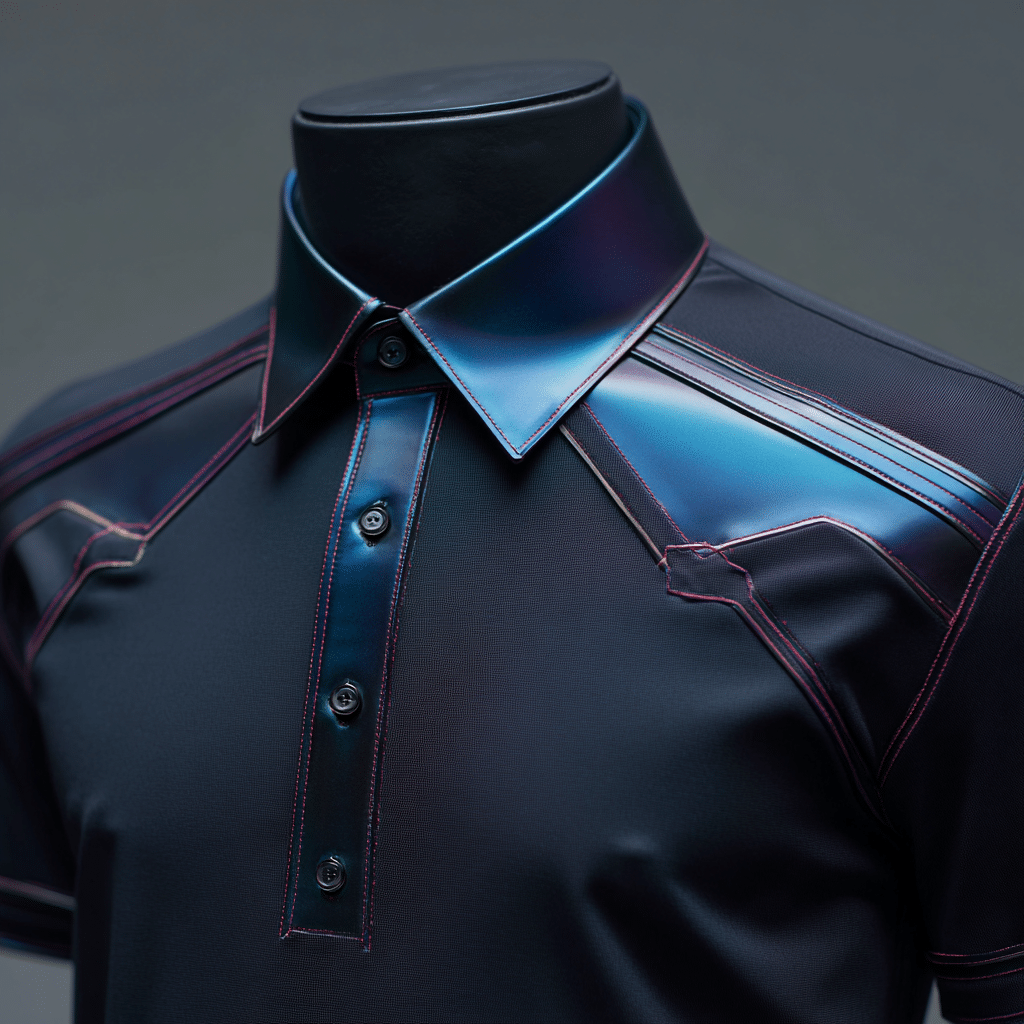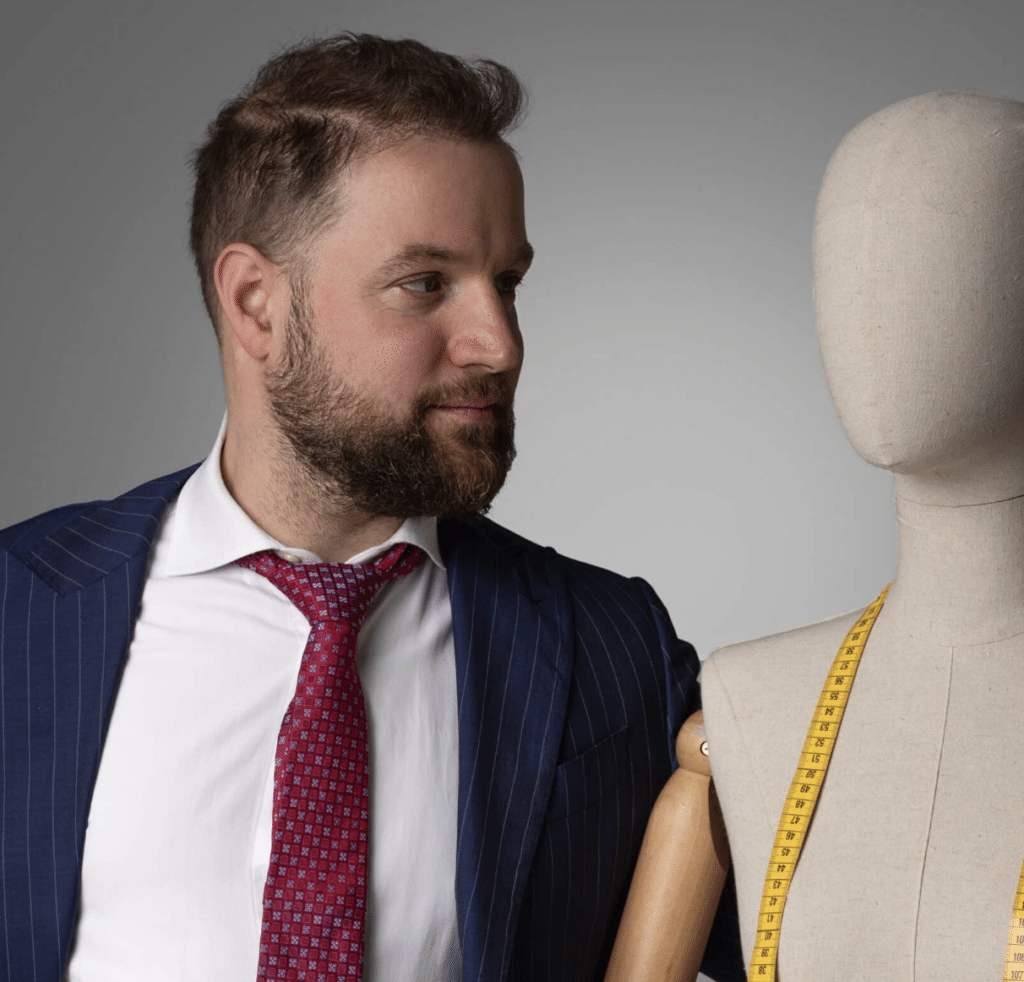Why should you launch a golf clothing brand? Actually, this question probably deserves several answers.
Among many sports, golf is the one in which the fashion and style play a unique roleThere is certainly a 'uniform' or dress code for golf, but unlike team sports, each player is still given the freedom and flexibility to display his or her own personal style.
Polo shirts, jumpers with visible collars, comfortable trousers and hats with visors: we all know the pillars of this style, based on a colour palette ranging from neutral tones to pastel colours.
But in the 2025 It is no longer just about that, all the more so at a time when interest in the sport is also shifting among younger people.
According to the latest data from the PGA TourA striking fact clearly emerges: about one in two golfers (48%) belongs to the 6-34 age group. In parallel, a recent study by the National Golf Foundation (NGF) shows that between 2020 and 2022, 26% of those who play golf in the US will be women.

Numbers that show how the profile of the golfer is changing rapidly, opening up new opportunities for sportswear brands who want to intercept an increasingly young, diverse and cool audience.
The 2025 is the perfect year to enter this growing marketwhere tradition and innovation come together to create extraordinary opportunities for visionary designers.
I am Corrado Manenti, founder of Beadesignerthe first style office to unite entrepreneurial mindset and creativity to bring your fashion projects to life.
In this article, we will explore the origins of the fusion of golf and fashion, trends 2025, and how you could successfully enter the sportswear market! And if you are an avid golfer, you will have a significant advantage: you will be your own best (and most critical) potential customer!
Golf and Fashion: the winning idea of Byrdie Golf Social Wear
Rachelle Wates has always lived golf as an integral part of her life. Growing up on the fairways, she soon realised how difficult it was to find clothes that were both suitable for playing and stylish to wear after a game.
From this need was born, in 2020, Byrdie Golf Social Wearthe brand co-founded with Hayden Shoffner that combines sporty performance and refined style. Rachelle's idea is as simple as it is effective: to create a clothing line inspired by the vintage elegance of country clubs, but reinterpreting it in a modern, versatile and fashion-oriented way.
Not just polo shirts and technical skirts, but real lifestyle garments that players can wear for an entire day, from the green to the aperitif. An innovative project that intercepts a new generation of golfers, who are increasingly younger and more attentive to fashion and the functionality of the garments they wear.

A concrete opportunity that combines fashion and golf in a rapidly expanding market where the percentage of women players continues to grow rapidly, confirming the potential of a new consumer segment that seeks style, comfort and performance even on the golf course.
Golf clothing, origins and evolution over the years
Golf is a sports without a mandatory official uniform, but this does not mean that it lacks style. On the contrary, it is precisely this absence of precise rules that makes it unique, fascinating and sometimes eccentric. Much of the success of the golf style derives from its history.
Originating in Scotland, the first records of the game of golf date back as far as 1457. In this land of pouring rain and biting wind, the early players protected themselves with short woolen trousers, laced below the knee and called 'plus-fours'. In the United States, these same trousers were strictly paired with long argyle socks, dubbed 'knickers'.
With the growing popularity of golf at the turn of the century, pre-1900 golf apparel was largely inspired by the Victorian-era fashion. Men often wore tight-fitting coats, high-necked shirts and knee-length trousers, while women wore long skirts, blouses and wide-brimmed hats: clothing that allowed freedom of movement and offered some protection from the weather.

Golf fashion as we know it today developed largely in the 1940s, at least for men: it was then that we first saw short-sleeved jerseys, light trousers or shorts, usually khaki or checked, and spiked shoes on the green.
At the same time, professional golfers were desperate to redeem themselves from their amateur (but very rich) colleagues, and found their spiritual guide in Walter Hagen, golf's first real influencer. Shirts, silk ties, cashmere jumpers and two-tone shoes: Hagen dressed so elegantly that it was questionable whether he was ready for a match or an exclusive party. To imitate him was to elevate oneself socially (as well as stylistically).
In later years, to dominate the fairways came Jimmy Demaret, another professional known as much for his sporting successes as for his brightly coloured suits. So eclectic and fashionable that he was dubbed 'The Wardrobe'.
So why do golfers dress, and dress themselves, like this? The answer is simple: because they can.
The Fashionisation of Golf
Nicole Kliest, freelance pen and former golf equipment signature on Vogueperfectly sums up the fascination with golfwhich does not only arise from the well-struck blow, but from theslow' atmosphere surrounding him. "It is an open-air, convivial ritual, where the pace remains deliberately relaxed and performance stress stays off the green“.
It is precisely this relaxation - free of the technical constraints typical of high-impact sports - that opens the door to thepersonal expression: “On the fairway you can experiment, play with colours, give space to your style without feeling out of place". In other words, golf becomes the most informal catwalk there is, perfect for those who want to combine sociability, sport and sartorial taste.

No wonder, then, that luxury brands and retailers are launching tennis- or golf-inspired collections for a new generation of players, to be worn both on and off the court, focusing increasingly on the lifestyle rather than on technical performance.
From the high-tech lines of Nike Golf to the refined collection NOCTA by Drake, passing by the celebrities on social media (Tom Holland, Justin Bieber, Michael Jordan to name a few) who do not miss a chance to post their game moments with their impeccable outfits: golf has returned to make the hearts of designers and trend-setters beat faster.
The truth is that the real power of this type of clothing lies in the fact that it manages to give a unique 'aura' and charm to anyone who wears it, even if they are just starting out. Even the most street looks retain a certain aplomb thanks to the typical combination of elements from golf, without subverting the basic style.
Since when did golf clothing become mainstream
The revival of golf among the younger generation is not the result of chance, but the result of a series of stages that have intertwined business, pop culture and fashion.
The numbers speak for themselves: Millennials and Gen Z are already the largest segment of luxury goods consumers today and, according to the True-Luxury Global Consumer Insight 2023, by 2026 will control three quarters of the market, having spent almost EUR 200 billion in 2022 alone.

With this exponentially growing purchasing power, it was inevitable that brands and golf courses would try to seduce them. Clubs have responded by opening their doors with 'experience' formulas that can be booked even by those who have never held an iron in their hands, loosening labels and reverential silence to make way for music, food trucks and social sharing.
One pole at a time: current numbers and future golf scenarios
According to Maximize Market Research, the global golf apparel market is worth over $4.5 billion today and will grow annually by 6.2% to reach $7.2 billion by 2032. In parallel, the equipment market - irons, smart balls and high-tech accessories - has reached $9.18 billion and is estimated to reach $12.6 billion by 2032.
A significant expansion, fuelled by the introduction of connected tools that enhance the gaming experience, capturing the attention of Millennial and the Gen Zdigital native and innovation-oriented generations.
But what are the elements that make golf so attractive to new consumers? First of all, theaccessibilityInnovative formulas such as Topgolf have broken down barriers to entry, allowing young people to approach the sport in a more informal and fun way. Fashion did the rest: exclusive capsules signed by Louis Vuitton, Nike with NOCTA by Drake or streetwear collaborations such as Travis Scott brought a wave of freshness to the green, intercepting the aesthetic preferences of a younger, trend-conscious public.
The message for those considering creating a new golfwear brand is clear: the market is hot, the room for growth is there, and the 2025 could be the ideal year to intercept a new generation of golfers' desires for style, performance and innovation.
The trends of 2025: what's new in golf clothing?
Having established the fact that the 2025 trend is the golfcorehere are the trends to wear and propose.
1. Performance-Tech & Sustainability
Shirts and polo shirts in fabrics such as polyamide, elastane, merino and organic cotton offer elasticity, breathability and UV protection. Brands such as Holderness & Bourne experiment with 'Airation' fabrics with micro-holes, while Rhone e lululemon offer soft but high-performance sweatshirts.
2. Extended customisation
From TRUE Linkswearwith laser-customisable trainers and accessories, to customised driver covers by Dormie Workshopmade-to-order becomes a strong point. Golf clothing is increasingly becoming a personal expression.

3. Bold patterns & street mix
Macro prints such as those of Amble o Not A Wallflower Club complement micro graphic patterns, while graffiti-style trousers by Malbon Golf dialogue between golf and street culture in an original way.
4. Neutrality sought
Accidental' colours such as 'icy blue' - as versatile as a neutral - and essential palettes of Honors e Williams Athletic Club make outfits elegant and easy to match.
5. Contemporary silhouettes
Women's width-forward pants, 70s-inspired joggers, hoodies and men's tracksuits inspire comfortable yet stylish garments, as proposed by Tory Burch, GG Blue e Kastel Denmark.
6. Spikeless and technical footwear
Shoes like the FootJoy HyperFlex, l'Adidas Adizero ZG and the Nike Air Max Plus G combine grip on the field and city style.
7. Hybrid accessories
Waterproof headwear by Fury Athletix, jewellery-tech like RFID card holders DashClipand modular 'après-golf' bags offer functionality and fashion appeal.
For a emerging brand in 2025the perfect mix is performance + customisation + urban style: innovative materials, versatile design and patterns with character form a golfwear capable of moving between green and city without losing uniqueness.

Golf and greens, beyond the hole: sustainability among the new values
La sustainability is no longer an optional detail for those who dream of launching a new golf wear brand: it is the strategic compass that can turn a simple creative project into a solid, desirable and relevant enterprise.
Let's start with a brutal fact: more than 95 % of the garments on the greens today are made of polyester, nylon or elastane derived from virgin oil, fibres that do not degrade and shed microplastics with every swing.
Who decides to found a clothing brand in 2025 cannot ignore this impactespecially in a sport that literally lives immersed in nature. Integrating sustainability right from the concept - choosing recycled fabrics from bottles, fishing nets or coffee grounds, working with suppliers who reduce water and energy and certify decent wages - is not just an ethical gesture: it is a tangible competitive advantage.
New generation golfers reward brands that respect fairways as much as people, environmental regulations become stricter, investors demand credible ESG reports.
Plus, the narration of a circular path - from the regenerated raw material to the take-back programme that brings garments back at the end of their life - offers a powerful storytelling to be shared in pro-shops and on social media, fuelling belonging and word-of-mouth.
So the brand stopped selling 'technical polo shirts' and started to propose a healthier way of playing, consistent with the values of concentration, balance and care of the course that are typical of golf.
The BAD method for building your golf brand
The journey of creating a golf clothing line begins with a deep understanding of one's audience.
- Who are the golfers today?
- What do they look for in a golf garment?
The answer to these questions guides the conception phase and subsequently, in a more articulate manner, the brand designwhere the focus is on building a stable architecture that reflects the personality and needs of modern athletes and non-athletes.
To give your brand direction we will use our tool Fashion Business Designer™created by Be A Designer, to make the whole creative process 'simple' and 'understandable'.

DISCOVER HOW TO USE THE FASHION BUSINESS DESIGNER CANVAS
SUBSCRIBE TO THE NEWSLETTER AND DOWNLOAD FOR FREE:
Click on the button below
and follow the instructions:
The creation of a new golf brand in 2025 comes with several challenges, first and foremost positioning itself in a premium market segment in an industry where competition is fierce.
This choice implies the adoption of a short supply chain although more expensive, than ensures high quality products, with the possibility of negotiating smaller quantities.
Aiming for excellence in such a competitive market gives the right to create something new and innovative, potentially opening the door to a niche market willing to pay more for higher quality products.
This process takes shape through amarket analysis in-depth, aimed at clearly identifying specific needs, emerging trends and possible niches not yet explored.
This is a strategic phase that, in our projects, we carry out very carefully during the Brand Designthus enabling us to identify original points of view and distinctive angles to create winning brands even in highly competitive sectors such as golfwear.
Precise definition of your target audience allows you to structure a targeted offer proposal that exactly meets the expectations, desires and specific needs of that market segment.
THE BE A DESIGNER PORTFOLIO OF OUR LATEST PROJECTS FASHION
SUBSCRIBE TO THE NEWSLETTER AND DOWNLOAD FOR FREE:
Click on the button below
and follow the instructions:
The inclusion of these data and considerations in the business plan is crucial at this early stage, as it allows you to accurately plan both your initial investment and all subsequent steps in the development of your business in the world of technical and customised golf apparel.
Customise golf wear or create it from scratch?
La customisation in golf wear is like deciding to put your name on a polo shirt you just bought, while the creation from scratch is more like taking on the role of a master tailor in the act of creating a masterpiece, with the difference that instead of traditional needles and threads, you work with technical fabrics and innovative technologies.
Entering the world of private label means having the opportunity to translate your dreams into reality, creating clothing that not only sets you apart on the greens in terms of style, but to meet needs that have emerged in the industry.
To work on brand positioning, it is therefore indispensable to invest time and resources in the development of avisual identity that is both representative and memorable, worthy of word of mouth between holes and drinks on the green.
But which garments to choose?
Composing a customised golf apparel line requires precise attention to how we plan to develop our business model.
To ensure an exclusive and effective offer, the structure of a collection ideally starts with no more than 12 pieces. This number makes it possible to maintain a focused offer, which is essential to stand out in the market.
Among the most popular garments to customise in golf are:
- Technical polosthe basis of golf wear, combining classic style and modern performance
- Golf trousersboth long and short, designed for maximum freedom of movement
- Jackets and pullovers: essential to cope with different climatic conditions
- Hats and visorsiconic accessories that complete the golfer's look
- Glovesoften overlooked but essential for grip and comfort
Fabrics and materials: the right choice to make par
When it comes to fabrics for golf wear, two of the best performing materials are undoubtedly microfibre and technical polyester.
Choosing the right fabric is crucial to ensure maximum comfort during play, especially when considering technical performance in terms of:
- Breathabilityindispensable quality that allows moisture to evaporate
- Stretchto ensure freedom of movement during the swing
- Resistanceto last while retaining shape and colour
- UV protection: essential for long sessions in the sun

We rely on some of the best manufacturers of technical fabrics the world, like Carvico e Eurojerseyreal ambassadors of Italian manufacturing quality. A significant competitive advantage for those who wish to create a brand that expresses Italianness e superior qualityespecially in the exclusive world of golf.
Storytelling as the key to your brand
In order to be talked about and remain in the minds of potential customers, the story must go beyond the functionality of the garments.
As demonstrated by The Power of Storytelling in Golf Brand Marketing of Divot Collective, authentic and engaging stories create deep emotional connections, distinguishing a brand in a saturated market.
In the activewear sector, every polo shirt, every jacket, every pair of trousers must speak of passion for the game, aspiration to perfection and the desire to express oneself. With BADI encourage designers to design garments that are not just objects, but woven narratives: from the choice of materials to the athlete's experience.
As in a gripping tale, each element - logo, size, texture - becomes a 'character' that brings with it memories of the field, challenges won and moments shared. The result?
Activewear that not only dresses, but accompanies, inspires and builds loyalty. Thanks to this emotional storytelling, the brand sells not just golf clothes, but experiences to be lived on the green, becoming an accomplice to the aspirations of the wearer.
From vision to product: prototyping and development
Once the foundations of the brand have been established, it is time to going from concept to reality. This means turning ideas into tangible prototypesready to be tested, evaluated and finished.

La prototyping is a crucial phase: it allows us to check fit, comfort, functionality of fabrics, quality of finish and aesthetic consistency with the brand identity.
In the case of thegolf wearvariable climatic conditions, extensive and continuous movements and the need to wear the garments for many consecutive hours must be considered.
Collaborating with experienced modellers e workshops specialising in sportswear is the best way to obtain high-level prototypes, ready to be possibly improved before launch.
Choosing the right suppliers: quality and reliability
To produce technical golf apparel that lives up to the expectations of the premium audience, the choice of suppliers is decisive.
This is why we rely on excellent Italian manufacturers and garment workshops specialising in the processing of stretch and performance fabrics, allowing us to maintain high quality standards and offer a product in line with the chosen positioning.
Reliable suppliers also mean more precise production timesgreater attention to finishes and sartorial customisation skills.
Distribution strategies: where and how to sell?
Define a coherent distribution strategy with the brand is essential. In golf, the distribution channels can be different and integrated with each other:
Owned E-commerceto directly tell the brand story and offer a complete shopping experience
Golf club pro shopideal to get in touch with a loyal and passionate clientele
Trade fairs and sporting eventsto introduce the collection to buyers, distributors and the specialised public
B2B Collaborations: with companies, clubs or tournaments that want customised technical supplies
Each channel must be thought of not only in commercial terms, but also in terms of experiential and relationalespecially in a sport like golf where perceived value is everything.
FAQ.
1. Can I order small quantities?
Yes, we also offer limited or made-to-order productionideal for clubs, teams or exclusive events.
2. Are fabrics suitable for all seasons?
We use technical fabrics designed for every season: light and breathable in summer, thermal and windproof in winter.
3. How long does it take to produce a customised collection?
From confirmation to prototype: approx. 3-4 weeks. For the complete production: 6-8 weeksdepending on complexity.
4. Is it possible to create an entirely eco-friendly line?
Absolutely. We offer fabrics recycled, reclaimed and environmentally friendly production solutions.
5. Can I integrate customised accessories into the collection?
Yes, you can add hats, belts, gloves, socks and other accessories to complete your brand image.
6. Is it compulsory to already have a logo?
No. We can help you in the logo creation or restylingwith a dedicated brand design team.
Do you have an idea? Let's build it together.
Whether you want to create an exclusive line for your club, launch your brand or simply stand out on the green in style, we are here to listen.
👉 Book a free call now with our team and tell us about your project.
We will talk about vision, style, materials and strategies tailored to your world.
No commitment, just concrete ideas. And maybe the first step towards something big.


















